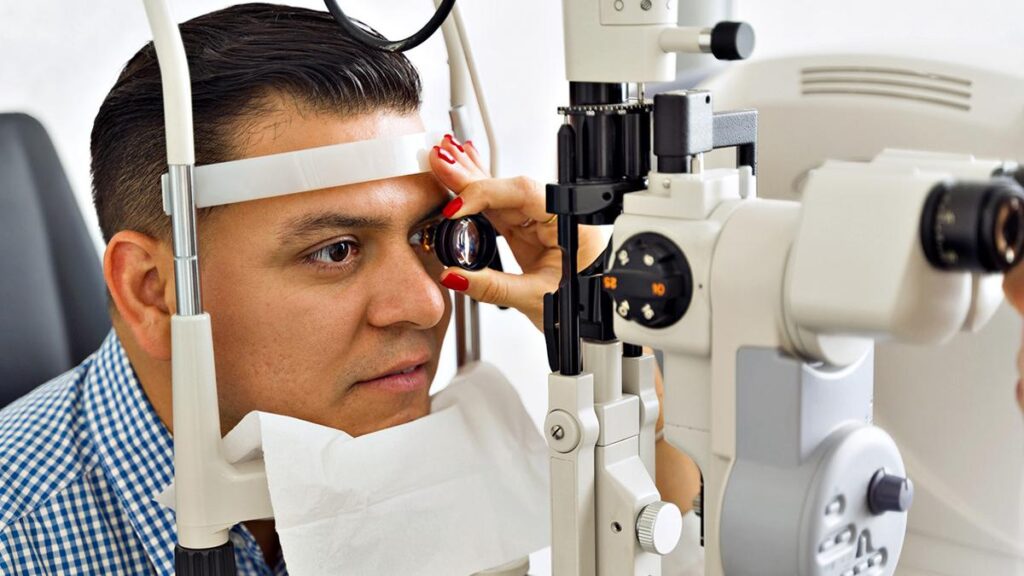
Regular, comprehensive eye exams can help detect glaucoma early. Photograph used for representational purposes only
| Photo Credit: Getty Images
Glaucoma is an eye condition that damages the optic nerve. The optic nerve, located at the back of each eye, carries visual messages from the eye to the brain, to help you see. When the optic nerve is damaged, it can lead to blindness. Glaucoma is one of leading causes of vision impairment and blindness globally.
In India, glaucoma is the third-leading cause of blindness after cataract and refractive errors, as per a 2023 research paper, Prevalence of glaucoma types, clinical profile and disease severity at presentation: Tertiary Institute based cross-sectional study from South India, by Praveen Kumar Seth et al. Glaucoma contributes to 12.8% of blindness in India, the paper said.
How does glaucoma occur?
Glaucoma is caused by an increase in pressure inside your eye. Everybody’s eyes constantly make a clear fluid known as aqueous humour that nourishes the eye. When new aqueous humour is made, an equal amount is drained out, through an an area called the anterior chamber angle (or the angle) — where the iris and cornea meet together at an angle. This drainage of the aqueous humour is crucial to maintaining the pressure in your eye, or intraocular pressure. When the drainage is blocked or does not work properly, the fluid builds up in your eye, your eye pressure increases, and this damages the optic nerve, causing vision loss.

What are the types of glaucoma?
There are two main types of glaucoma: open-angle glaucoma and closed-angle glaucoma.
In open-angle glaucoma, there is a gradual build up of eye pressure that eventually damages the optic nerve. This is caused by the aqueous humour not draining from the eye properly. The cause of this is unknown. In the early stages, there may be no symptoms or warning signs. Over time, people may experience blind spots in their peripheral vision (edges/sides of the vision), but because this takes place slowly, people may initially be unaware that their vision is changing. Open angle glaucoma can run in families. Without treatment, it can eventually lead to blindness.
Closed-angle glaucoma or angle-closure glaucoma occurs when the drainage of the aqueous humour is suddenly blocked, leading to the eye pressure rising quickly and severely. This can happen because the iris is blocking or narrowing the drainage angle. This type of glaucoma is a medical emergency and needs immediate treatment.
There are other types of glaucoma as well, such as secondary glaucoma that can be caused due to an underlying condition or disease or injury and congenital glaucoma that occurs in babies when the eye does not develop properly.
What are the signs and symptoms and who is at risk?
In open-angle glaucoma, most people do not have any symptoms — this is why glaucoma is called the ‘silent thief of sight’. It is important to have regular, complete eye examinations in order to be able to detect this form of glaucoma as early as possible.
Symptoms of angle-closure glaucoma may include headache, eye pain, double vision, blurred vision, nausea, seeing halos/rainbows around lights. It is vital to see an eye doctor immediately to help prevent vision loss.
People over the age of 60 are at risk of developing glaucoma. There is also a risk if there is a family history of glaucoma and in people who have diabetes or high blood pressure. Other risk factors include decreased corneal thickness, being far-sighted or near-sighted.
The 2023 research paper found that of the 6,120 cases of glaucoma studied, more than half of all these eyes were blind due to glaucoma at presentation. The paper also noted that with India having one of the highest burdens of diabetes in the world, diabetic retinopathy-related complications including neurovascular glaucoma are on the rise. It also said that while both primary and secondary glaucoma were more prevalent in males, this was also perhaps because Indian women were less likely to seek medical care due to social or financial reasons.

What are the treatment options?
There is no cure for glaucoma, and the damage it causes is permanent and cannot be reversed. However, treatment can help stop further vision loss. Glaucoma is usually treated with eyedrop medications to help lower eye pressure. Treatment options also include laser procedures to drain the fluid and surgeries to improve the drainage.
Early detection and treatment can help prevent vision loss: regular, comprehensive eye exams and knowing and managing risk factors and maintaining healthy habits can all go a long way.
Published – February 20, 2025 05:04 pm IST

